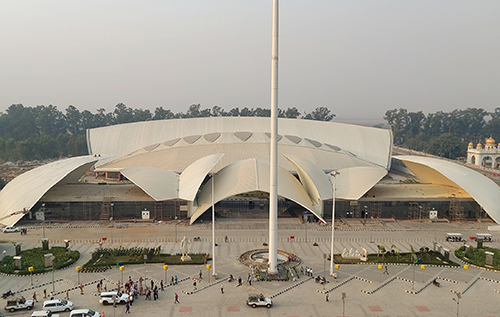The Kartarpur Landport Building is dynamic,modern, green and an epitome of sustainable design, writes “Our impulse is to sensitize our designs towardspassive strategies of green architecture. Not only do we try to derive ourinspiration from nature but also we let the building breathe with nature.”

Ar.Gurpreet Singh Shah.
The buildings that we create are supposed to bea reflection of the environment they are built in. With the arrival of newtechnology, construction techniques and a modern lifestyle, we are keen to giveour buildings a modern look, often forgetting the impact it will have on theenvironment. What is required on our part as architects is a consciousness ofour actions and a careful reinterpretation of traditional, regional, andcultural aspects, to coexist within the parameters of contemporary times.
The Landport Terminal Building, KartarpurCorridor is one such project that brings together culture, sustainability,modernity, and faith. The project, which is located at the India-Pakistanborder, forms a spiritual link between the two nations. The work on thiscorridor is a landmark in the history of both countries and is proving to be ahelpful resource in creating unity. It shows that both the nations can lookbeyond physical boundaries and collectively work for the betterment of theircitizens.
FactFile
Location :Kartarpur
Client : Land PortAuthority of India
Year : 2019
Cost : 150-cr(1.5 billion)
SiteArea : 15 Acres
BuiltArea : 20,000 sq.m
Scope : Masterplan, Comprehensive Architecture, MEP, and Structure Engineering services.
Sikhs suffered great loss during the partitionof India in 1947. There was loss of not only lives and property but also openaccess to more than 75 per cent of their most historically significantGurudwaras was lost. This also included the birthplace of Guru Nanak and theSikh faith.
The Sikh community in India and abroad werefinding it difficult to visit these shrines due to visa-related hassles. TheGurudwara could only be seen using binoculars from across the Indian side ofthe international border.
[1image3:n!]
Devotees on the Indian side would step onto a10-foot platform that was built in the town of Dera Baba Nanak to gain adarshan (glimpse) of the Darbar Sahib, Kartarpur, where Guru Nanak spent thelast 18 years of his life.
With the construction of the Kartarpur Corridor,the times of gazing at the Darbar Sahib, Kartarpur from a distance are now adistant past! The 550th birth anniversary of Guru Nanak was amilestone in Sikh history as the global Sikh community finally gained theopportunity to visit the birthplace of their religion.
The Corridor was inaugurated on 9th November2019, celebrating Guru Nanak’s 550th Birth Anniversary by PrimeMinister Shri Narendra Modi on the Indian side and his counterpart Imran Khanon the Pakistan side. The project was next to impossible to complete as thedeadline was in a mere six months.
The construction of the Kartarpur Corridor hashelped the Darbar Sahib at Kartarpur in Pakistan gain global attention. Thecorridor serves as a literal ‘gateway’ for interfaith harmony.
Through the continuous efforts of Ar. GurpreetShah and his team at Creative Group, the project became a reality. This was arare project where the architect was wholly responsible for everything – fromdesigning, obtaining permissions and getting approvals to landscaping,sculptures, art works, paintings, and services.
Ar. Gurpreet Shah aced this mammoth task, andthat too, in record breaking time! The project is a success because of thearchitect’s inception of intelligent planning, efficient zoning, andsustainable building strategies.
The endeavour was to design a global facilitywhich is Green, Smart and Sustainable, and, at the same time, resonates withthe culture, heritage, topography, and social fabric it belongs to. Thisproject has been envisioned as a physical homage to the great Guru Nanak Dev jiand also to create sensitivity of Art and Architecture in symbolizing theuniversal message of oneness and humanity.
This was achieved through various elements ofvisuals, dimensions, space, and volume, thus establishing an environment whichis spiritually empowered, emotionally bonded and soulfully connected whichjustifies the statement made by Prof. Charanjit Singh Shah: “A building shouldnot be treated as a mass of brick and concrete but as a living organism whichbreathes and embodies within the nature”.

The project was a great opportunity for Ar.Gurpreet Singh Shah as both an architect and an urban planner. The project hasthe power to connect both the nations spiritually, and plays on the emotionalsentiments.
TheBuilt Form and the Guru
The project aims to spread the message of GuruNanak. The building form originates from Khanda- spiritual symbol of Sikhreligion; and is designed in the contemporary era. The story of Guru Nanak andhistorically significant sculptures are incorporated which empower thereligious beliefs of the people.
The gateway that is crowning the port iscomposed of five petals which symbolize the five vows of Sikhism. Guru Nanak’suniversal message of oneness of God and truthful living is conceptualized bythe Mool Mantra – Ek Onkar Satnam – and has been very exhaustively expressedwithin the Landport building and into the landscape through contemporary art andarchitecture.

The key architectural interventions in the Landportbuilding are:
Wallof fame: Guru Nanak’s philosophy and life events.
The Wall of Fame showcases the journey of GuruNanak Deviji since his birth, episodes of his understanding, his realizations,and his journey towards enlightenment. His various Udasi’s – or, travels – coveringmore than 40,500 km across the globe is depicted in the form of Modern Art. Thishelps form a connection between the devotees and their Guru.
RapidConstruction: Prefabricated Steel Structure.
The frame of the building is entirelyconstructed out of steel, with use of trusses and various steel sections toachieve large open spans using off-site prefabricated construction. Thecladding on the roof is of Aluminium Standing Seam while some areas also usezinc cladding.
Gurbaniin the landscapes area.
The landscape area in the site is lined withstone blocks that have the words of the Guru carved in them. This area is tohelp feel as though they are united with their guru as one.
3Principals of Guru Nanak.
Statues of the three principles of Guru Nanak,namely Naam Japna (focus of God), Kirat Karni (honest living), and Vand Chakna(sharing with others) have also been embedded in the landscape. The verses andteachings of other great saints, such as Kabir, Permanand, Jaidev, and Ravi Dashave also been incorporated into the landscape to showcase universalbrotherhood and how the teachings of Guru Nanak Devji goes beyond theboundaries of religion.
The design is divided into six zones. Themovement within the Landport building is mostly unilateral. This was done toease the passenger flow as the building caters to 10,000 users each day. Thismakes all the necessary checks smooth and efficient.
In the evening, the passenger flow direction isreversed. Hence, the same type of areas can be used. This helped in optimizingthe built-up area of the facility.
The Passenger Terminal is Gold Rated by GRIHAand has also won the ASSOCHAM GEMS Platinum Green award. Passive designstrategies have been used to make the terminal sustainable and eco-friendly.
The project is a perfect example of engineeringgoing local and addressing all the socio-enviro aspects of construction stream.The design respects the natural topography of the site and the construction isdone without disturbing the existing contours and trees located on the site.
The terminal is a great example of holisticarchitecture. The built form is contemporary, but has its roots and essenceembedded in Sikhism. The form and spaces are designed so as to pay homage toGuru Nanak Dev.
The corridor marked the possible beginning of anew era of cooperation and a symbolic movement in the shared cultural historyof Punjab. It was a proud moment for the firm to be appreciated by the Hon’blePrime Minister Shri Narendra Modi, on the eve of Independence Day 2020.
The Passenger Terminal is a prestigious projectfrom National as well as International view point joining the two countries onthe grounds of spirituality, peace, and love. It is a dynamic modern greenbuilding and the epitome of sustainable design.
The facility has been developed as an airportterminal. The spaces are designed so as to give the user a spiritualtransforming effect. It is architecture that is born out the soul, and that iswhat makes it all the more magical and important!
Ar.Gurpreet Singh Shah, M.S in Urban Design, recipient of William Kinne Fellowshipaward, Columbia University, New York has more than a decade of local andinternational architecture and urban design experience. With his vision todeliver a new generation of Global Infrastructure, Ar. Shah has pioneeredsustainable infrastructure designs in India.